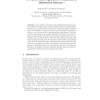Free Online Productivity Tools
i2Speak
i2Symbol
i2OCR
iTex2Img
iWeb2Print
iWeb2Shot
i2Type
iPdf2Split
iPdf2Merge
i2Bopomofo
i2Arabic
i2Style
i2Image
i2PDF
iLatex2Rtf
Sci2ools
GC
2004
Springer
2004
Springer
A Physics-Style Approach to Scalability of Distributed systems
Abstract. Is it possible to treat large scale distributed systems as physical systems? The importance of that question stems from the fact that the behavior of many P2P systems is very complex to analyze analytically, and simulation of scales of interest can be prohibitive. In Physics, however, one is accustomed to reasoning about large systems. The limit of very large systems may actually simplify the analysis. As a first example, we here analyze the effect of the density of populated nodes in an identifier space in a P2P system. We show that while the average path length is approximately given by a function of the number of populated nodes, there is a systematic effect which depends on the density. In other words, the dependence is both on the number of address nodes and the number of populated nodes, but only through their ratio. Interestingly, this effect is negative for finite densities, showing that an amount of randomness somewhat shortens average path length.
Related Content
| Added | 01 Jul 2010 |
| Updated | 01 Jul 2010 |
| Type | Conference |
| Year | 2004 |
| Where | GC |
| Authors | Erik Aurell, Sameh El-Ansary |
Comments (0)

